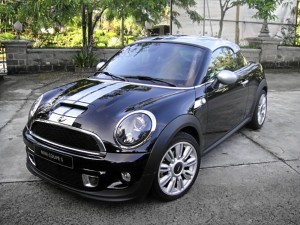
The Coupe quickly became controversial because of its funky looks and diminished utility. Did BMW execute a coup by creating the MINI Coupe? That question is academic if you believe that any product that stirs a controversy is okay precisely because it gets noticed and talked about.
What immediately grabs your attention when you see a MINI Coupe for the first time, aside from its groovy sport stripes, is its low, squat roofline, which resembles a helmet or a baseball cap squashed backward on top of a MINI Cooper body. While many think it makes the MINI Coupe look awkward and unattractive (to put it mildly), some say it’s actually cute.
Smallest. Cute, maybe, because the Coupe is the smallest MINI yet, but it’s not the kind of cuteness that would put it in danger of being branded a chick car or mom mobile because it is hardly useful as a practical means of private transportation. The Coupe’s cabin is cramped, it has no back seat and offers only 9.8 cubic feet of weirdly shaped cargo space, compared to the four-seater hatchback’s 24.8 cubic feet.
Given these limitations, a MINI buyer would logically choose a hatchback rather than the Coupe S which costs the same (P2.950 million) as the S hatch. But the Coupe’s practical shortcomings are somewhat compensated by its adrenalin-pumping performance characteristics and handling. The 1.6-liter, 4-cylinder twin scroll turbo engine of the MINI Coupe S with fully variable valve timing delivers 184 hp @ 5500 rpm and 260 Nm @ 1600-5000 rpm max torque through a 6-speed Steptronic automatic transmission with shift paddles on the steering wheel. It zooms from zero to 100 kph in 6.9 seconds and its top speed is 230 kph. Yet it averages 13.47 km per liter in combined city and highway driving.
Stunning. The Coupe weighs 100 pounds more than the MINI hatchback, but it delivers stunning acceleration, sharper handling, reassuring stability, cornering agility and less body roll since it has a lower roofline and a lower center of gravity. It is built on a convertible chassis and thus has structural reinforcements and a stiffer body structure. Despite its front-wheel-drive platform, the Coupe S returns to a neutral balance faster than the hatch when it is flung around on twisty roads. Like all MINIs, the Coupe is so solidly built, with impeccable fit and finish so that it seems to have been forged rather than assembled.
Not minimalist. The MINI Coupe S is by no means minimalist in terms of creature comforts. A centrally located, pizza-sized visual display, called the head unit, and with interactive options, dominates the dash while retro-style toggle switches control lights, windows and door locks. The Radio MINI CD with six speakers is standard equipment. You can customize the instrument panel, steering wheel, armrests, interior surfaces and upholstery, as well as the light alloy wheels, body color and roof color of the Coupe, according to your personal taste and budget.
Small but safe to drive, the Coupe is equipped with four airbags, Dynamic Stability Control, Dynamic Traction Control with electronic limited slip differential, adaptive headlights, disc brakes on all four 16-inch wheels with ABS and Cornering Brake Control and Electronic Brake Force Distribution.
On the other hand, the Coupe S’ sport-tuned suspension provides a stiffer, less comfortable ride compared to the hatchback’s and plenty of noise and harshness on uneven road surfaces. Critics say that the Coupe performs only a teeny weeny bit better than the hatchback by sacrificing the back seat, cargo room, rearward visibility, riding comfort and over-all usefulness—if not aesthetics. The additional sporty driving dynamics are not enough to warrant the loss of all those things, they say.
Assuming, but not granting, that argument to be true, then the MINI Cooper Coupe is an expensive novelty, a pricey toy, an impractical pocket rocket that only wealthy individuals who have bigger, more utilitarian cars would buy. How I wish I were one of them!